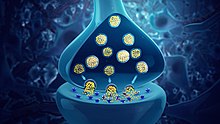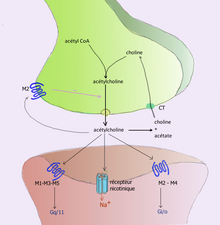User:Good2bheretoday/Neurotransmitter
| This is the sandbox page where you will draft your initial Wikipedia contribution.
If you're starting a new article, you can develop it here until it's ready to go live. If you're working on improvements to an existing article, copy only one section at a time of the article to this sandbox to work on, and be sure to use an edit summary linking to the article you copied from. Do not copy over the entire article. You can find additional instructions here. Remember to save your work regularly using the "Publish page" button. (It just means 'save'; it will still be in the sandbox.) You can add bold formatting to your additions to differentiate them from existing content. |
Article Draft
[edit]Excitatory, Inhibitory and Modulatory Effects
[edit]A neurotransmitter may have an excitatory, inhibitory or modulatory effect on the target cell. The effect is determined by the receptors the neurotransmitter interacts with at the post-synaptic membrane. Neurotransmitter influences trans-membrane ion flow either to increase (excitatory) or to decrease (inhibitory) the probability that the cell with which it comes in contact will produce an action potential. Synapses containing receptors with excitatory effects are called Type I synapses, while Type II synapses contain receptors with inhibitory effects.[1] Thus, despite the wide variety of synapses, they all convey messages of only these two types. Each type has a different appearance and is located on different parts of the neurons under its influence. Receptors with modulatory effects are spread throughout all synaptic membranes and binding of neurotransmitters sets in motion signaling cascades that help the cell regulate its function.[2] Binding of neurotransmitters to receptors with modulatory effects can have many results. For example it may result in an increase or decrease in sensitivity to future stimulus by recruiting more or less receptors to the synaptic membrane.
Mechanism and Cycle
[edit]
1. Synthesis
Neurotransmitters are generally synthesized in neurons and are made up of or derived from precursor molecules that are found abundantly in the cell. Classes of Neurotransmitters include amino acids, monoamines, peptides, and monoamines are synthesized by altering a single amino acid. For example, the precursor of serotonin is the amino acid tyrosine. Peptide transmitters, or neuropeptides, are protein transmitters that often are released together with other transmitters to have a modulatory effect[3]. Purine neurotransmitters, like ATP, are derived from nucleic acids. Other neurotransmitters are made up of metabolic products like nitric oxide and carbon monoxide.
| Examples | |
|---|---|
| Amino Acid | glycine, glutamate |
| Monoamines | serotonin, epinephrine, dopamine |
| Peptides | substance P, opioids |
| Purines | ATP, GTP |
| Other | nitric oxide, carbon monoxide |

2. Storage
Neurotransmitters are generally stored in synaptic vesicles, clustered close to the cell membrane at the axon terminal of the presynaptic neuron. However, some neurotransmitters, like the metabolic gases carbon monoxide and nitric oxide are synthesized and released immediately following an action potential without ever being stored in vesicles[4].
3. Release
Generally, a neurotransmitter is released at the presynaptic terminal in response to a threshold action potential or graded electrical potential in the presynaptic neuron. However, low level 'baseline' release also occurs without electrical stimulation. Neurotransmitters are released into and diffuse across the synaptic cleft, where they bind to specific receptors on the membrane of the postsynaptic neuron. [5]
4. Receptor Interaction
After being released into the synaptic cleft, neurotransmitters diffuse across the synapse where they are able to interact with receptors on the target cell. The effect of the neurotransmitter is dependent on the identity of the target cell's receptors present at the synapse. Depending on the receptor, binding of neurotransmitters may cause excitation, inhibition, or modulation of the postsynaptic neuron. See below for more information.
5. Elimination
In order to avoid continuous activation of receptors on the post-synaptic or target cell, neurotransmitters must be removed from the synaptic cleft.[6] Neurotransmitters are removed through one of three mechanisms:
- Diffusion – neurotransmitters drift out of the synaptic cleft, where they are absorbed by glial cells. These glial cells, usually astrocytes, absorb the excess neurotransmitters. In the glial cell, neurotransmitters are broken down by enzymes or pumped back into
- Enzyme degradation – proteins called enzymes break the neurotransmitters down.
- Reuptake – neurotransmitters are reabsorbed into the pre-synaptic neuron. Transporters, or membrane transport proteins, pump neurotransmitters from the synaptic cleft back into axon terminals (the presynaptic neuron) where they are stored for reuse.

For example, Acetylcholine is eliminated by having it's acetyl group cleaved by the enzyme acetylcholineesterase, the remaining choline is then taken in and recycled by the pre-synaptic neuron to synthesize more acetylcholine.[7] Other neurotransmitters are able to diffuse away from their targeted synaptic junctions and are eliminated from the body via the kidneys, or destroyed in the liver. Each neurotransmitter has very specific degradation pathways at regulatory points, which may be targeted by the body's regulatory system or medication. Cocaine blocks the dopamine transporter responsible for the reuptake of dopamine. Without the transporter, dopamine diffuses much more slowly from the synaptic cleft and continues to activate the dopamine receptors on the target cell.[8]
Peer Review:
[edit]Great organization. The information flowed well and was easy to follow.
I think that the first section doesn't need to mention glial cells. What you have now describes a neurotransmitter well. If glial cells were added I think a lot more explanation would be needed. For now, the topic is appropriately covered.
In your section '1. Synthesis', you list monoamines twice, I think that was just a typo.
To replace the title 'life cycle' you might consider 'pathway'EAGMIL (talk) 02:42, 10 December 2021 (UTC).[9][10][11]
This is my second peer review. I could be wrong, but it seems like you added a figure since my last review. I think that the figures look great and help demonstrate what you describe in your writing! I think all of the writing is the same as last time I read through it. Overall, great job!EAGMIL (talk) 02:42, 10 December 2021 (UTC)
References
[edit]- ^ Peters, Alan; Palay, Sanford L. (1996-01-01). "The morphology of synapses". Journal of Neurocytology. 25 (1): 687–700. doi:10.1007/BF02284835. ISSN 1573-7381.
- ^ Di Chiara, Gaetano; Morelli, Micaela; Consolo, Silvana (1994-06-01). "Modulatory functions of neurotransmitters in the striatum: ACh/dopamine/NMDA interactions". Trends in Neurosciences. 17 (6): 228–233. doi:10.1016/0166-2236(94)90005-1. ISSN 0166-2236.
- ^ Purves, Dale; Augustine, George J.; Fitzpatrick, David; Katz, Lawrence C.; LaMantia, Anthony-Samuel; McNamara, James O.; Williams, S. Mark (2001). "Peptide Neurotransmitters". Neuroscience. 2nd edition.
- ^ Sanders, Kenton M.; Ward, Sean M. (2019). "Nitric oxide and its role as a non-adrenergic, non-cholinergic inhibitory neurotransmitter in the gastrointestinal tract". British Journal of Pharmacology. 176 (2): 212–227. doi:10.1111/bph.14459. ISSN 1476-5381. PMC 6295421. PMID 30063800.
{{cite journal}}: CS1 maint: PMC format (link) - ^ Elias, L. J, & Saucier, D. M. (2005). Neuropsychology: Clinical and Experimental Foundations. Boston: Pearson
- ^ Chergui, K.; Suaud-Chagny, M. F.; Gonon, F. (1994-10-01). "Nonlinear relationship between impulse flow, dopamine release and dopamine elimination in the rat brainin vivo". Neuroscience. 62 (3): 641–645. doi:10.1016/0306-4522(94)90465-0. ISSN 0306-4522.
- ^ Sunita, Thapa; Min, Lv; Hui, Xu (2017-11-30). "Acetylcholinesterase: A Primary Target for Drugs and Insecticides". Mini-Reviews in Medicinal Chemistry. 17 (17): 1665–1676. doi:10.2174/1389557517666170120153930.
- ^ Vasica, Gabriella; Tennant, Christopher C. (2002). "Cocaine use and cardiovascular complications". Medical Journal of Australia. 177 (5): 260–262. doi:10.5694/j.1326-5377.2002.tb04761.x. ISSN 1326-5377.
- ^ Fields, R. Douglas; Ni, Yingchun (2010-10-05). "Nonsynaptic Communication Through ATP Release from Volume-Activated Anion Channels in Axons". Science Signaling. 3 (142): ra73–ra73. doi:10.1126/scisignal.2001128. PMC 5023281. PMID 20923934.
{{cite journal}}: CS1 maint: PMC format (link) - ^ Sanders, Kenton M.; Ward, Sean M. (2019). "Nitric oxide and its role as a non-adrenergic, non-cholinergic inhibitory neurotransmitter in the gastrointestinal tract". British Journal of Pharmacology. 176 (2): 212–227. doi:10.1111/bph.14459. ISSN 1476-5381. PMC 6295421. PMID 30063800.
{{cite journal}}: CS1 maint: PMC format (link) - ^ Bargas, José (2017-08-15). "'Synaptic autocontrol'". The Journal of Physiology. 595 (16): 5405. doi:10.1113/JP274545. ISSN 1469-7793. PMC 5556171. PMID 28626995.
